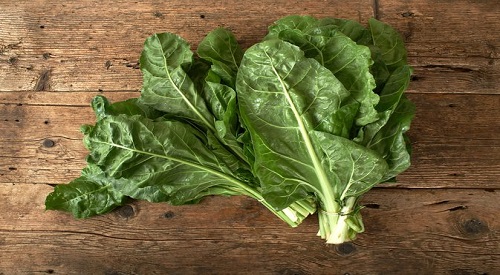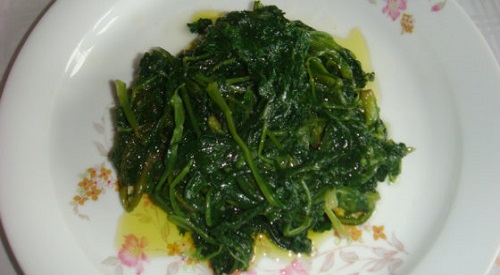Wanna know how to reduce oxalic acid in spinach, kale, and other green leafy foods, especially those you can’t imagine doing without? Well, you are reading the right post.
Basically, we have two answers for this, one is using an enzyme and two is through boiling the spinach using the steps shared below. I begin with the simplest and surest option you can use to neutralize oxalates in foods. Using a special enzyme.
I found this really effective oxalate reducing enzyme that amazingly breaks down oxalic acid in any food you eat. The stuff works by splitting oxalate into smaller compounds using an oxalate decarboxylase enzyme. After that, it again binds the acid particles and disintegrates them farther into much smaller pieces. Which essentially reduces oxalate levels in your body, and makes it super easy to pass out the compound naturally through urine — click here to see exactly how this oxalate neutralizing enzyme can help you (Amazon link).
All you do is add the enzyme to any beverage you’ll be eating the food with, at least two times a day — no complicated procedures. Well, to me this is a fine way to eat spinach because it ensures oxalate content is dealt with before it lands on to the stomach.
On the other hand, you might want to go the manual way on how to reduce oxalic acid in spinach. This also applies to foods like kales as well not only spinach, your other favorite leafy greens too.

Personally, spinach leaves are one of my favorite green smoothies (but unfortunately, a table by uchospitals.edu says it has very high oxalate amounts — 656 to 755 mg per serving (see some charts in this article).
But still, I can’t imagine going two weeks without them. Well, below are a few how to neutralize oxalic acid in spinach — steps you can take to reduce this compound manually.
How to Reduce Oxalic Acid in Spinach:
Step 1
Take your spinach leaves, wash them to eliminate dust and dirt, and then mash them on running water before cooking – at this point expect a few particles of the compound would get washed away. But more so, doing this makes the oxalic acid to be released and would be cooked out of the food.
Step 2
This involves boiling on purpose your spinach or whatever green vegetable you want to reduce its oxalate content. Doing so helps to split down and loosen oxalic acid in them. Now here is the thing, the longer you boil or cook your spinach the more you’ll be weakening the oxalic acid bonds so the oxalate can get released, (off cause don’t overcook, 5 – 12 minutes of boiling is enough.
Step 3
Make calcium carbonate your immediate tool. As in adding it to your leafy greens (in this case spinach) while cooking. Besides the effect cooking has on loosening the oxalic acid, calcium carbonate does even more by bind on the oxalic acid, and extracting it from the food. Now, the good thing about this is that you only need very little calcium carbonate to get the expected results, as little as 1 teaspoonful for a large pot. Use this calcium carbonate power for that work.
Step 4
To be exact I could have just mentioned, or included step (4) anywhere above in step 2 or 3 because it stems from them — decanting. Decanting the water after boiling or cooking the spinach is what I am talking about. So the understanding is that after you have reduced the strength of bonds that held the oxalic acid together in the spinach, and the compound is deposited in the water, now you can drain them drown the sink. This has been known to significantly lower oxalate concentration in many foods, not only spinach to be precise.
Step 5
This may sound obvious but it is really good that you keep in mind. As much as your doctor put you on a tight low oxalate diet, try to reduce the number of times you eat spinach (because it is so rich in oxalic acid). The same applies to all other foods that naturally have a high place in the oxalate graph. Our article on foods high in oxalic acid chart explains that better.
Basically, I’d recommend that you stick to eating such foods a few times a week, let’s say twice or thrice a week. It’s also wise that you use effective oxalate reducing agents like the one I mentioned in paragraph two above when using such foods. As in, you can’t go wrong when you are mindful of your oxalic acid health.
What is Oxalic Acid?
To be particular and on point, oxalic acid is another name for oxalate, and it is a naturally occurring chemical substance that is commonly found in leafy greens. So whenever the term oxalic acid and oxalate are used interchangeably, simply know that they mean the same thing.
Most greens, especially spinach have this chemical in huge amounts per serving, but again the concentration varies with the soil and the environmental surrounds the plant grew in.
Why you may want to know how to neutralize oxalic acid in spinach and other oxalate-rich foods

There are many reasons as to why it’s wiser to manually lower the oxalate levels in your foodstuff. If you are oxalate sensitive, eating more of this chemical increases your chances of facing what doctors call ‘oxalic acid foods side effects” or “oxalate consequences.’
When talking about oxalic acid foods side effects we are simply focusing on the bad that comes with eating oxalic-acid-rich-foods, which end up depositing more oxalates in a person’s body. However, worth mentioning upfront is that oxalic acid is mostly harmful to people with certain conditions, not just everybody.
People susceptible to kidney stones, fibromyalgia, and leaky-gut are the most likely lot to mind about this topic. Doctors take that the side effects, in this case, are simply pointers showing oxalate levels have built up and are causing mayhem.
The side effects of eating excess oxalic acid foods include: Increased chances of oxalate crystal formation: These are small needle-like pieces of “condensed substances” that form after oxalic acid combines with calcium in a person’s body. The particles in question can grow to become bigger pebbles and when they get stuck in the kidney they are called kidney stones.
Top on that the crystals can lodge in the muscles or damaged sites in the body especially around the joints – which end up fueling a severe pain in fibromyalgia patients. What this means, in other words, is that those eating foods that are lesser in the compound would help decrease the amount of oxalic acid that gets absorbed into the body.
Kidney Impairment: There is an article on Livestrong showing proves from Clinical Nephrology confirming that indeed oxalic acid causes damage to kidneys, you can read it here. Just to summarize, after the compound (oxalate) gets absorbed from the intestines into the bloodstream after it has joined with calcium. The substance gets accumulated around the kidneys, which makes things harder for the organs to filter oxalate crystals out of the bloodstream.
Oxalate Poisoning: yes, that’s another side effect that follows eating high oxalate foods, according to different pieces of research. Among other first aids options to oxalate poisoning, the person should take in plenty of milk or water.
However in case the affected has other symptoms that won’t allow him or her to swallow, emergency care from a qualified health practitioner should be sought immediately, or help from the poison control board by calling their helpline. Other side effects might come as:
- Fatigue and body pains from oxalate crystal accumulation
- Oxalate muscle pains and fibromyalgia
- Painful kidney stones
- Frequent urination
- Serious gut issues
- Or even more joint pain complications
Another reason to this is that maintaining a safer oxalate profile, by either consuming low oxalates or reducing oxalates means you’ll not spend on medical bills or waste time seeking medications.
The good thing is that so far, there’s a clear-cut line between what foods are high in oxalates and those that are low in the compound. Simply grab a low oxalate cookbook, get it cheaply from the shopping links on this website and use it as your guide for low oxalate meal plans.
I hope the above steps on “how to reduce oxalic acid in spinach” were of value to your low oxalate living journey. If yes, let’s hear your views about neutralizing oxalates in foods below in the comment section.

Be the first to comment